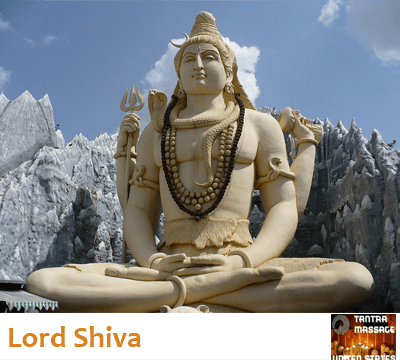Tantra Massage US
Find A Tantra Practitioner In Your Area
Shiva Male Energy
Home >> Shiva Tantra
Shri Shiva, Shiwa or Śiva (Sanskrit: शिव) is the highest divine being within Ishvara, one of the great traditions within Hinduism. With Brahma and Vishnu, he forms the Trimurti of creator-instant-destructor. Shiva is the destroyer.
Other names of Shiva are:
- Tryambaka (the three-eyed one)
- Mahakala (Great Time)
- Nilakantha (Blue Neck)
- Sri Kanta (He whose neck is beautiful)
- Girisha (the Lord of the Hills)
- Sankara, Hara
- Gangadara (Bearer of Ganga)
- Nataraja (Lord of Dance)
- Ardhanarishvara (the Lord who is half woman)
- Bhagavat (Lord)
- Panchanana (Five-headed)
In his appearance as Panchanana (Five-headed), Shiva acts as a physician. With his wife Parvati, Shiva inhabits Mount Kailasa in the Himalayas.
Meaning of the word Shiva

In the writings of the Vedas and the Tantras and other sources, three meanings of the term Shiva emerge.
- The first and most important meaning of Shiva is well-being. Shiva is sometimes seen as one who promotes well-being in all kinds of ways (by assuming all kinds of roles). To give form to all these ways or roles, Shiva is depicted with five different faces, two on the left, two on the right and one in the middle.
- The second meaning of Shiva is supreme knowledge or knowledge of the Supreme Being (without attributes) beyond any existential bondage.
- The third meaning is the person Sadáshiva who was born in India about seven thousand years ago. Sadá means always and Shiva means well-being. Sadáshiva means one whose sole existential mission is to promote the overall well-being of all beings.
Significance of the coming of Shiva
The first form of Shiva (Rudra) arose at the end of the Rig-Veda era and at the beginning of the Yajur-Veda era. The collective teachings of the rishis (sages) and munis (scholars), called Arsha Dharma, were constantly subject to change. For example, with time, from one Veda to another, the system of recitation and pronunciation of mantras changed. Saivism as a form of Bhakti originated in South India probably in the fifth century AD.
Family of Shiva
Numerous wives of Shiva appear in the very extensive mythology that has grown up around Shiva. The three wives of Shiva are the Aryan Párvati (Uma) or Gaorii, who hails from the Himalayan mountain range, the dark native Kálii, and the Mongolian Gaunga, who hails from Tibet. (Actually, these are the manifestations of Párvati mátá).
Párvati was the daughter of the king Himálaya. Daksha, father of Sati, an earlier incarnation of Párvati, allegedly humiliated Shiva by not inviting him to a yajina, an Aryan sacrificial ceremony. Sati could no longer tolerate the many insults to her husband and threw herself into the sacrificial fire. Shiva sent Virabhadra to take revenge on Daksha.
Daksha lost his head, but later received a goat's head in its place. During his wanderings after losing his wife, several women fell in love with Shiva. Their husbands then emasculated Shiva. From this, the cult of the linga (lingam) is said to have arisen. After the great sacrifice of Sati, relations between the Aryans and the natives are said to have improved.
Párvati had a son named Bhaerava. Bhaerava means one who practices tantra sadhana. Kálii had a daughter named Bhaeravii, which means a woman who practices Tantra sadhana. Gaunga had a son named Kárttikeya or Kárttika (Skanda), who, to his mother's chagrin, did not do sadhana.
For this reason, Shiva is said to have coddled Gaunga, to comfort her, the most. Based on this story, about 1400 years ago during the Puranic period, people started depicting Gaunga on the hair of Shiva. Later, people began to associate this Gaunga with the river Gaunga (Ganges) and in the Puranic stories, the river flowed from the head of Shiva in four directions.
Ganesh, who has come to be regarded as a son of Shiva and Parvati in Puranic stories, seems to have been revered as a deity even before the time of Shiva in prehistoric times. Ganesha or Ganapati means the group leader or chief. The worship of Ganesha is said to have originated from the worship of the prehistoric chief.
To indicate his power, this leader was depicted as a well-fed powerful figure with the head of a powerful animal, the elephant. Ganesha received the head of the white elephant Airavata from Indra. Shiva is also considered the father of the maruts, the storm gods.
Characteristics of Shiva
Shiva's attributes include the trident (trishula), the axe (parashu) and the lasso. As Lord of the Dance (Nataraja), he carries a drum (damaru). He wears the crescent moon (Chandra) on his head and is covered with ashes. Shiva has a blue throat (nilakanta), because he drank the halahala poison, which was released during the churning of the Melkocean (Samudra manthan).
He has three eyes, wears an elephant skin, sits on a tiger skin and the white bull Nandi is his means of transportation. In his guise as a physician, Shiva has five heads (Panchanana). The lingam is the symbol, with which Shiva is worshipped. The yoni is that of his wife Parvati. As Ardhanarishvara, Shiva and Parvati are part of one body. Their residence is Kailash and Benares (Varanasi, Kashi) is his beloved city.
Schools and points of view in Shaivism
The bhakti sects of Shaivism see Shiva as the one true God from whom all other deities are emanations. Smartas believe that Shiva is one of the many forms of the universal Atman or Brahman. In Gaudiya Vaishnavism, Shiva is seen as the best devotee of Vishnu. While to Vishnu in Vaishnavism all kinds of avataras (avatars) are attributed, this is not the case with Shiva.
There have been some people who claimed to be an embodiment of Shiva such as Adi Shankara and more recently Haidakhan Babaji, also known as Mahavatar Babaji, who lived from 1970 to 1984. There are also some legends and teachings, which mention that Shiva would have manifested spontaneously to intervene in certain events. Some consider Hanuman to be an aspect of Shiva, In the teachings of Ananda Marga, Shiva is a Mahakaula, as is Krishna.
Mahakaula
The Mahakaula (literally Great Kaula) is a concept from tantric yoga that stands for a great personality already fully realized at birth who is both able to bring his own kulakundalini to the highest chakra (definition of a kaula), and able to do so for any other individual. Usually, in tantra, only Shiva is considered the Mahakaula, but sometimes, for example, Krishna is also considered a Mahakaula.
Since it is assumed in tantra that only God is able to grant enlightenment to any being, the Mahakaula is seen as a special manifestation of God that cannot be compared to anything else. The term Mahakaula has also entered the tantric yoga of the Vajrayana (see Mahakala), but is used differently there.
Shiva is often depicted dancing the tantric tandava dance. In Hindu mythology, this dance represents the energy that flows through the world, causing the rhythms of day and night, the seasons, birth and death.
The most important holiday for Shiva is Mahashivaratri. The festival is celebrated in the Hindu month of Ma(a)gha or Phalgun (Feb/March) on the thirteenth or fourteenth day after the full moon. The main mantra of Shiva is Om Namah Shivaya, which means as much as I bow to, surrender to Shiva.




